Chicken Run.
Posted on | January 24, 2013 | 4 Comments
As everyone knows, a new year calls for a new plan. Last year’s plan was to make the guineas pay for farm expenses around here. After all, back in 2011 the guineas were so ridiculously prolific, without any assistance from us, that we had to give some of them away to keep the squawking down to a level that would not damage our ear drums. Also to keep the neighbors from sneaking up to the house and assassinating us in our sleep. Although they may have actually attempted this until the cacophony of guinea alarm calls when they came up the drive sent them scurrying home, bleeding from their ears. Either way, we were up to our wattles in guineas and keets that year.
Too bad in 2012, the year of the Guinea Profitability Plan, there were 8 guinea eggs. Which we incubated. So we had 8 new guineas. And that was all. I’d explain how the plan went wrong but it’s a boring litany of woes. Suffice to say that guineas prefer spontaneous population explosions, not planned ones. They’re very locust-y that way.
But as I always say, “Onward and upward!” When I’m not saying, “Who wants to go to the store for chocolate?” Both sayings which mean we refuse to give up on the theory of profitability and will try, try, and try again until we succeed. Or at least console ourselves with Snickers when we fail. ‘Cause we’re resilient like that.
So I have justified my Silkie chicken hoarding addiction purchases over the past year by telling The Other Half that it was part of my 2013 profitability plan. Thanks to the amazing propensity of pullets to actually develop into cockerels (despite owner assurances and hatchery guarantees to the alternative) we ended up with a white Silkie rooster among our initial batch of Silkie hens.
“Aha!” thought that conniving part of my brain that is always wondering how to hide feed bills from The Other Half lower feed bills. “I bet I could breed my Silkies and sell the offspring to raise extra cash. After all, Silkies are so pretty and….cute and….um, fluffy….and adorable!”
Which didn’t seem like enough to draw hoards of Silkie buyers to our place. So I did a little research to bolster my Silkie purchases. Which is how plans work around here. Run out and buy something that catches your eye, get a crazy idea stuck in your head, and then try to figure out later how it can all work together into cold, hard cash. I realize a lot of people do their planning in a different order—-such as getting an idea, researching it, and then purchasing the necessary components. Boooring.
I believe these are the same kind of people who read the entire recipe to see if they have all the ingredients before they start. As if you can’t just substitute stuff and come out with a dish even better than the recipe. You can’t recreate your fantabulous new dish, of course, because you were substituting random stuff for the items you didn’t have in the pantry. But duplication isn’t always as important as originality, people. You heard that here first. Unless you saw it in one of those cute little posters on Facebook. You know, the ones with the Victorian-dressed people and snarky sayings. God, don’t you just love those?
Anyway….
All of the research online seemed to be down on Silkies. Like how they are bad layers because they have small eggs and really don’t lay an egg every day. And they can’t see very well in order to detect predators and barely fly so they have trouble getting to safety quickly. Plus, they’re not great meat birds because they tend to be on the scrawny side.
Perhaps the only benefits listed were that they are a friendly breed, tolerating lots of handling, even from young children. And they are so broody that they will even try to sit a nest of golf balls. Which kind of makes them sound stupid. Every other animal in the barnyard knows young children are going to squeeze too hard or poke you in the eyeball. And that golf ball nests are for deterring snakes, not hatching chicks. But these factors completely ignore the benefit of how pretty they are. Awwwwww…..
(Well, other than their creepy feathery 5 toes. Shudder.)
Besides, if being pretty and stupid was a bad thing then there wouldn’t be all those reality shows on cable TV. And everyone loves reality shows on cable TV. I have discovered that reality shows with stupid, pretty people are perfect for when you’re working on knitting. They don’t require enough attention to mess up your counts or your stitching, you’ll finally know the characters (excuse me,.. the people) that the radio DJs are talking about when you’re driving the kids to school in the morning, and you can always say you’re not really watching it, you’re just knitting if someone catches you. Knitting is almost as fun as those posters with Victorian-dressed people and snarky sayings!
Anyway….
Since last year’s plan with the guineas was such a failure I decided I needed a back up plan. And my Plan B involved my other spontaneous purchase of chickens last spring—-some Welsummer chicks from the local feed mill. I was just in there, minding my own business, mortgaging my house for goat feed, when I heard peeping from the corner where he keeps his brooder. I immediately knew several things:
1. Spring chicks had arrived.
2. I was going over just to look at the spring chicks. Just to look.
3. I was going to leave there with some spring chicks and a bag of chick feed.
Chicks are like crack, people. Like crack. You tell yourself you’re not going to buy anymore. You do fine as long as you’re at home or work. You feel strong and confident when digging in the garden or forking hay in the barn. You’re not even tempted, not even thinking about it, at the grocery store or the bank or the library. But then you step into the feed mill and the owner shows you his supply and you feel weak, you tremble, you shake, you HAVE TO HAVE SOME, YOU HAVE TO DO IT! And so you come home ashamed and guilty and turn on the heat lamp in the brooder room, fill the little feeder and waterer, and sit there soaking in all that fluffy, adorable, cuteness that is so good and so bad all at the same time.
And then The Other Half gets home and comes out to help with the barn chores and looks up in confusion and betrayal and asks,
“Is that….more chicks?”
And I am forced to say, “Officer, those are not my chicks. My cousin borrowed my car and those chicks were in the back seat when he gave it back to me. Also, someone drove by the back pasture, right before you got here, and dropped some chicks out the window before driving off. You know me, man, I’ve been chick-free for 6 months and I would never, never touch the stuff again. I’m telling you those chicks are not mine.”
I feel your pain, junkies, I feel your pain.
But in this case, those Welsummers made an excellent backup plan. Welsummers have an incredible dark brown egg, coveted by many chicken owners. My pullets had already been leaving proof of their productivity in the nest boxes.
Of course, one of the Welsummer pullets turned out to be a rooster. And all of this together meant I was coming into 2013 with a breeding flock of Silkies and a breeding flock of Welsummers. All without any forethought or preparation on my part. Which seems less like a plan, actually, and more like predestination. And who am I to argue with predestination?
All plans do require some action eventually. So after spending November and December stuffing my face pondering the practicalities of hatching purebred chicks, I decided I would separate the Welsummers into the completely enclosed back pen of the barn. It has chicken wire walls that rise to the roof of the barn, an automatic waterer, and roosts already in place.
The Silkies could go into my spare goat breeding pen which only had pallet walls, a low roof, and a dog house. Since Silkies can’t fly well I figured they couldn’t get out of that space. And since a lot of my Silkies slept on the ground anyway, they didn’t need roosts, and they could nest and sleep in the dog house.
With the housing in place, I just needed to separate the Welsummers and the Silkies from the rest of the free range flock. Catching Silkies is a bit like shooting fish in a barrel, for all of the reasons we discussed earlier. I’m pretty sure they couldn’t see me reaching for them and it never occurred to them to fly away. So in just a few minutes after throwing out the morning scraps I had captured the 3 white Silkies. I went back for Blackberry, the black Silkie. Who was still sitting on the concrete block next to the waterer. Where she sleeps every night. I’m not sure why she does this. Except that, due to her fluffy bangs, it takes her a long time to find the feed in the feed trough at night. Then it takes her long time to find her way from the feed trough to the waterer. And probably by that time she’s so exhausted that she just hunkers down for the night. And hopes the rooster lets her know when the sun comes up. Because I’m not sure she can see that either. Oh, the terrible price of beauty!
Too bad containing Silkies is a lot harder than catching them. Because the first thing that Thunder, the Silkie rooster, did was get out. I found him the next morning running with the rest of the free rang chickens. Huh.
So I clipped his wings and put him back in the pen with his Silkie ladies after doing the morning milking.
I found him out again during the evening chores. Running with the Buff Orpingtons. Apparently he likes his ladies a bit thicker in thigh. And although I can appreciate a chubby chaser as much as the next girl who loves chocolate cake for breakfast, his tendencies were interfering with my 2013 profitability plan. So I explained this to him, tossed him back in the pen, and hung a tarp from the ceiling to deter him from flying or jumping out. Whichever he had been doing.
Too bad the next morning I found him out again. So I was forced to put him back in the pen and then busy myself untangling baling twine in the barn. With my back to his pen but my peripheral vision on the look out for his feathery topknot. Until I finally saw him, out of the corner of my eye, sliding through a tiny gap where the gate met the pallets. Which was a relief. Because it’s probably a bad start for the new plan to get derailed by a 2 pound Silkie rooster. Kind of makes you question the whole predestination thing.
In any case, I got out my tool kit, rehung the gate, and attached an additional board to the pallet to cover the gap. Ha! That’s a good one! Of course, I didn’t do that. I got an old sheet out of the kidding barn, balled it up, and stuck it in the hole. Mission accomplished, time leftover for another cup of coffee, and Thunder has yet to defeat the sheet.
I would feel bad about confining the little guy. Except he now has 3 lovely ladies, all to himself, without any trouble from the bigger roosters hanging around. Plus, he still gets a view of his favorite Buff when she’s finishing the grain out of the milking stand each morning. I think it’s his favorite side of her. ‘Cause he likes big butts and he cannot lie.
Once the Silkies were on their way to laying their golden eggs for us, it was time to catch the Welsummers. Who can see and fly just fine. There are no pictures of that little expedition. Because we only spent a few sunlight hours trying to snag those slippery chickens. Even with nets, we quickly decided it was better to come back after dark and just grab them off their roosts. It’s really tempting to try and grab a Welsummer hen as she saunters by in the barnyard, a few inches from your feet. Or as she stands next to you, waiting for you to dump and refill the automatic waterer. Or when she’s lined up on the chicken coop roof, hoping to jump into the feed can as soon as you lift the lid.
Don’t bother. It’s embarrassing. The minute your mind thinks, “I bet I can grab that chicken,” her head comes up, she eyeballs you, and she gets ready to dash away at your first lunge. I know what you’re thinking. Chickens can’t hear your thoughts. Um, yes they can. They really can. Here’s a perfect example of a mind-reading Welsummer.
Just FYI: Once a chicken has gone into blurry mode, you’re not catching her. Not even with a net and 3 children to help corner her against the fence. Nope. Trust me on this.
With much dedication to the plan (It was cold out that night. Brrr…..), a flashlight, and a bunch of extra hands (If I have to be out in the cold catching chickens, so do the children.), we managed to get all 6 Welsummer hens and their rooster tucked into the back pen. The ladies settled right in.
The rooster didn’t mind trading his freedom for his own personal harem.
And he got right down to supporting the profitability plan. That guy’s a team player, I tell ‘ya.
Even better, all this was accomplished by the second week of January. Which means we can start collecting purebred eggs for the incubator by the first week of February. And the eggs can be put in the ‘bator by the first week of March. Then adorable, fluffy Silkie and Welsumer chicks will hatch in 3 weeks. And be ready for sale by Easter on March 31st.
Easter, people. When all the non-farming people are looking for chicks for their children’s Easter baskets or Easter parties or whatever reason it is that people always call me up and ask for chicks for Easter. Which I can sell to them. Along with an offer to take them back when they aren’t fluffy chicks any more and they find out their HOA doesn’t allow backyard poultry and their kids are grossed out by chicken poo. So I can then resell them to farming people who want chicks that don’t need to be under heat any more and are old enough to sex. Meaning I can hatch them once and sell them twice.
Muwhahahahaha!
Although it is worth mentioning that I was shocked to find a white egg in the Welsummer nest box.
Which means a few things:
1. This hen with a small comb is probably just one of my mixed breed hens, who only looked like a Welsummer by the light of the flashlight.
2. My back up plan may have already gone horribly wrong. In just the first few days of the plan. That’s probably a world record for how fast a plan can fail.
3. We may have to rely on the Silkies for all our profitability.
No pressure, Thunder. No pressure.
We’re just counting on you to feed the farm, buddy. No big deal. No biggie at all.
Comments

4 Responses to “Chicken Run.”
Leave a Reply
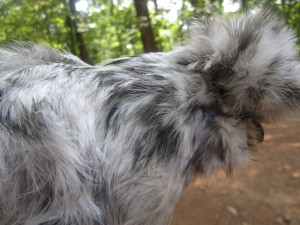
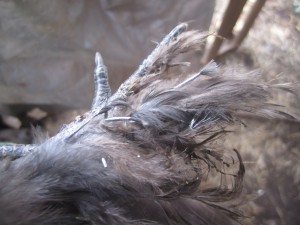
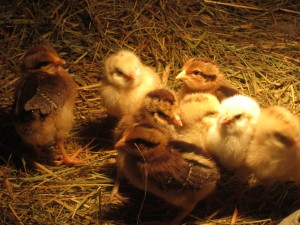
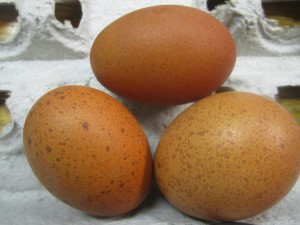
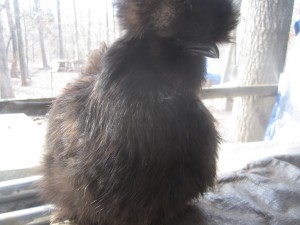

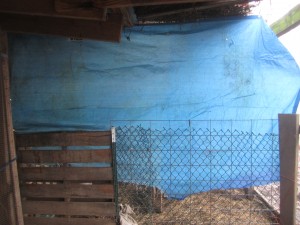
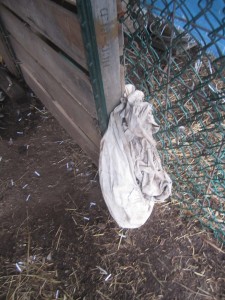
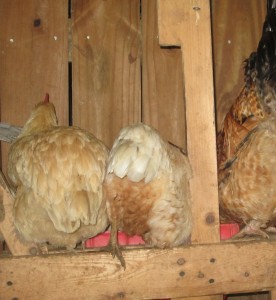

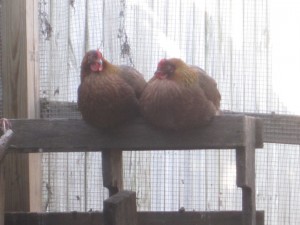
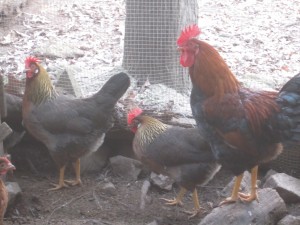
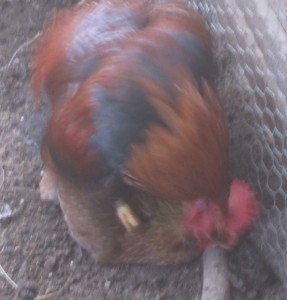
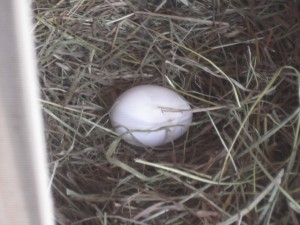
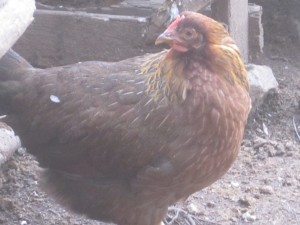

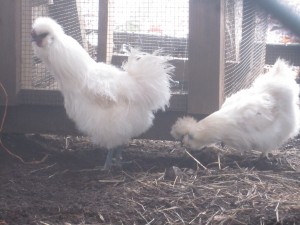



January 25th, 2013 @ 3:59 am
[…] for Blackberry. Who was crouched by her waterer. Even in her new pen. […]
January 25th, 2013 @ 11:34 am
The Other Half was confused? Really?
January 25th, 2013 @ 4:26 pm
Good Luck raising your chicks.
February 11th, 2013 @ 8:43 am
[…] room has been testing his crow. Apparently not all those Silkie chicks were pullets. Look out, Thunder. This little guy might be putting you to the test in the […]